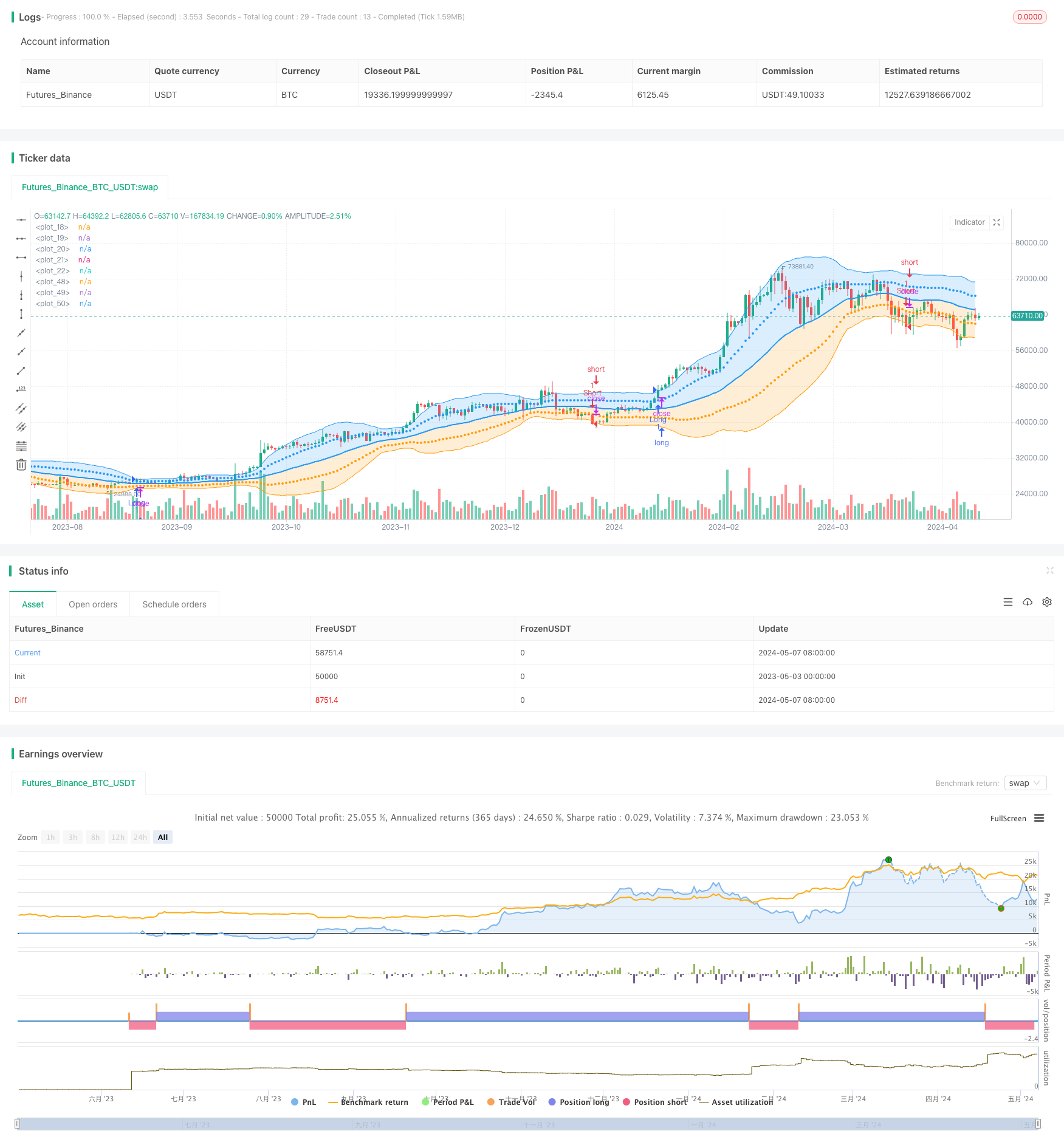布林带随机振荡器策略
Author: ChaoZhang, Date: 2024-05-09 15:59:11Tags: SMA

概述
该策略是一个基于布林带和随机振荡器的交易策略。它利用布林带来确定市场的波动范围,并使用随机振荡器来判断市场的超买和超卖状态。当价格突破布林带上轨时,策略进行做多;当价格跌破布林带下轨时,策略进行做空。同时,该策略还使用了随机振荡器来过滤交易信号,以提高策略的准确性和可靠性。
策略原理
该策略的核心是布林带和随机振荡器两个技术指标。布林带由三条线组成:中轨、上轨和下轨。中轨是价格的简单移动平均线,上轨和下轨分别是中轨加上和减去价格标准差的某个倍数。当价格突破上轨时,表明市场可能处于超买状态;当价格跌破下轨时,表明市场可能处于超卖状态。
随机振荡器由两条线组成:%K线和%D线。%K线衡量了收盘价在最近一段时间内的最高价和最低价之间的位置,%D线是%K线的移动平均线。当%K线上穿%D线时,表明市场可能处于超买状态;当%K线下穿%D线时,表明市场可能处于超卖状态。
该策略结合了这两个指标,当价格突破布林带上轨且随机振荡器%K线上穿%D线时,策略进行做多;当价格跌破布林带下轨且随机振荡器%K线下穿%D线时,策略进行做空。这种组合可以有效地捕捉市场的趋势,同时也能够避免在波动市场中频繁交易。
策略优势
- 结合了趋势和震荡两种市场状态的指标,能够在不同的市场环境中获得稳定的收益。
- 布林带能够动态地调整,适应市场波动率的变化,提高了策略的适应性。
- 随机振荡器能够有效地过滤掉一些虚假的突破信号,提高了策略的准确性。
- 策略逻辑清晰,易于理解和实现,适合不同水平的交易者使用。
策略风险
- 在市场趋势不明确或者波动率很大的情况下,该策略可能会出现较多的虚假信号,导致频繁交易和损失。
- 该策略依赖于历史数据,对于一些突发事件或者市场异常情况,可能会出现较大的回撤。
- 策略参数的选择对策略性能有很大影响,不同的参数可能会导致完全不同的结果。
策略优化方向
- 可以考虑加入更多的过滤条件,如交易量、其他技术指标等,以进一步提高信号的可靠性。
- 可以对布林带和随机振荡器的参数进行优化,找到最适合当前市场的参数组合。
- 可以引入风险管理机制,如止损和移动止损,以控制单次交易的风险。
- 可以考虑将该策略与其他策略进行组合,形成一个更加稳健的策略组合。
总结
该策略是一个简单而有效的交易策略,通过结合布林带和随机振荡器两个经典的技术指标,能够在趋势和震荡两种市场状态下获得稳定的收益。尽管该策略也存在一些风险和局限性,但通过适当的优化和改进,可以进一步提高策略的性能和适应性,成为一个值得参考和学习的交易策略。
/*backtest
start: 2023-05-03 00:00:00
end: 2024-05-08 00:00:00
period: 1d
basePeriod: 1h
exchanges: [{"eid":"Futures_Binance","currency":"BTC_USDT"}]
*/
//@version=5
strategy("Unique Bollinger Bands Strategy", overlay=true)
src = input(close)
length = input.int(34, minval=1)
mult = input.float(2.0, minval=0.001, maxval=50)
basis = ta.sma(src, length)
dev = ta.stdev(src, length)
dev2 = mult * dev
upper1 = basis + dev
lower1 = basis - dev
upper2 = basis + dev2
lower2 = basis - dev2
colorBasis = src >= basis ? color.blue : color.orange
pBasis = plot(basis, linewidth=2, color=colorBasis)
pUpper1 = plot(upper1, color=color.new(color.blue, 0), style=plot.style_circles)
pUpper2 = plot(upper2, color=color.new(color.blue, 0))
pLower1 = plot(lower1, color=color.new(color.orange, 0), style=plot.style_circles)
pLower2 = plot(lower2, color=color.new(color.orange, 0))
fill(pBasis, pUpper2, color=color.new(color.blue, 80))
fill(pUpper1, pUpper2, color=color.new(color.blue, 80))
fill(pBasis, pLower2, color=color.new(color.orange, 80))
fill(pLower1, pLower2, color=color.new(color.orange, 80))
// Parameters
bbLength = input.int(34, title="Length", minval=1)
bbMultiplier = input.float(2.0, title="Multiplier", minval=0.001, maxval=50)
// Source
priceData = close // Unique name for price data source
// Bollinger Bands Calculation
bbBasis = ta.sma(priceData, bbLength)
bbDeviation = ta.stdev(priceData, bbLength)
bbDeviationMultiplied = bbMultiplier * bbDeviation
bbUpperBand = bbBasis + bbDeviationMultiplied
bbLowerBand = bbBasis - bbDeviationMultiplied
// Plot Bollinger Bands
plot(bbBasis, color=color.blue, linewidth=2)
plot(bbUpperBand, color=color.blue)
plot(bbLowerBand, color=color.orange)
// Strategy Logic for Entry and Exit
enterLong = ta.crossover(priceData, bbUpperBand)
enterShort = ta.crossunder(priceData, bbLowerBand)
// Enter Long when price crosses over upper band
if (enterLong)
strategy.entry("Long", strategy.long)
// Enter Short when price crosses under lower band
if (enterShort)
strategy.entry("Short", strategy.short)
// Close Long when Short condition is met (i.e., price under lower band)
if (enterShort)
strategy.close("Long")
// Close Short when Long condition is met (i.e., price over upper band)
if (enterLong)
strategy.close("Short")
相关内容
- 多维度趋势判断与ATR动态止盈止损策略
- 自适应布林带趋势反转量化交易策略
- 高级多指标趋势确认交易策略
- 双均线-RSI多重信号趋势交易策略
- 自适应趋势跟踪与多重确认交易策略
- 动态调整止损的大象柱形态趋势跟踪策略
- 多均线交叉辅助RSI动态参数量化交易策略
- 多维度K近邻算法与烛台形态的量价分析交易策略
- 基于移动平均线和日内模式的智能追踪止损策略
- 自适应多策略动态切换系统:融合趋势跟踪与区间震荡的量化交易策略
- 多指标多维度趋势交叉高级量化策略
更多内容
- MACD双均线交叉策略
- 基于相对强弱指数的超买超卖自动化交易策略
- 基于支撑位和阻力位的技术分析交易策略
- RSI50_EMA长仓策略
- KDJ趋势跟踪与信号移动平均策略
- 成交量加权平均价与相对强弱指数交叉策略
- 移动平均线与相对强弱指数策略
- EMA动态趋势追踪交易策略
- 基于三根连续阴线和均线的动态止盈止损交易策略
- MOST与双均线交叉策略
- MACD RSI 一目均衡Ichimoku动量趋势多头策略
- 双均线交叉开仓策略
- 移动平均交叉策略
- RSI变动方向改变策略
- 基于连续MACD金叉死叉的交易策略
- 布林带突破策略
- 增强型布林带相对强弱指标交易策略
- 布林带标准差突破策略
- 随机震荡指标与移动平均线策略
- 枢轴动量策略